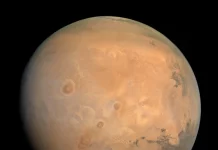
Mars may be dry, dusty, and far from hospitable today, but new research suggests it once shared more in common with Earth than we thought.
A team of scientists from the University of Rochester has discovered that the surface of Mars features soil patterns strikingly similar to those found in Earth’s coldest regions.
These patterns, called solifluction lobes, are typically formed by freeze-thaw cycles and slow-moving soil in places like the Arctic and Rocky Mountains.
The study, recently published in the journal Icarus, was led by Ph.D. student JohnPaul Sleiman and assistant professor Rachel Glade, alongside other collaborators.
The researchers used high-resolution satellite images to study nine craters on Mars and compared the surface textures with those found in frigid, mountainous regions on Earth.
They found that the wave-like formations on Mars closely resemble Earth’s solifluction lobes—not just in shape, but in geometric pattern.
This discovery hints at a deeper link between the two planets and how similar physical processes can shape landscapes in different environments.
These lobes on Earth are created when frozen ground partially thaws, loosening the soil and causing it to slowly creep downhill.
On Mars, where surface water is scarce and temperatures are far colder, scientists believe a similar process may have occurred—likely involving sublimation, where ice changes directly into vapor without becoming liquid.
Even without flowing water, this freeze-sublimate cycle could have moved Martian soil in a similar way.
Interestingly, the Martian versions of these lobes are, on average, 2.6 times taller than their Earth counterparts.
According to the researchers, this height difference matches expectations based on differences in soil properties and gravity between the two planets. With lower gravity and different surface conditions, Martian soil structures can grow larger before collapsing under their own weight.
The findings are important for understanding Mars’ ancient climate.
If these features were formed by icy processes, it suggests that Mars may once have experienced periods of freezing and thawing similar to Earth’s permafrost regions. This offers clues about the presence of ice or even the past existence of water—both essential ingredients for life.
Although it’s still unclear whether these Martian features formed recently or in the distant past, their presence helps paint a more detailed picture of the planet’s environmental history. The researchers believe this type of study could also help identify other planetary environments—on Mars or beyond—that might once have supported life or still do.
By studying the shape and behavior of soil, scientists are gaining valuable insight into Mars’ past and where future missions might search for signs of life.



